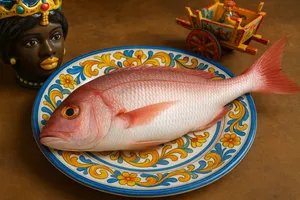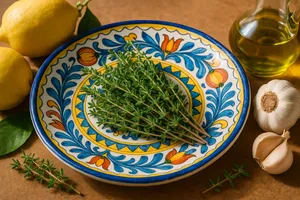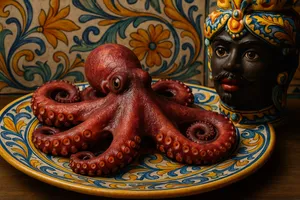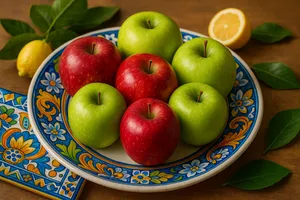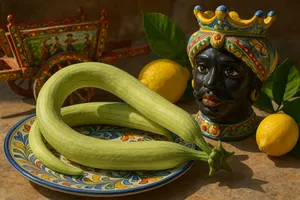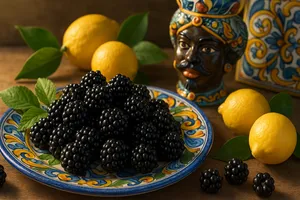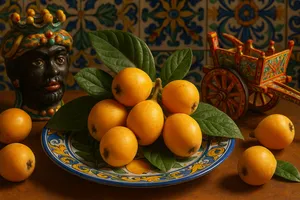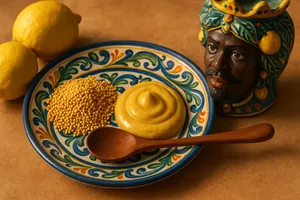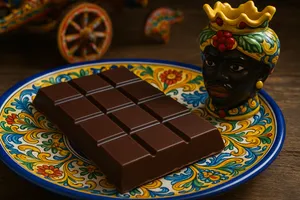Overview
Grouper is a prized sea fish belonging to the Serranidae family, highly appreciated in Sicilian cuisine for its firm, white flesh and delicate flavour. This fish, which can reach considerable sizes, inhabits the rocky seabeds and cliffs of Sicilian waters, living solitarily in crevices and caves, making it a coveted yet not always easy catch.
In the island’s culinary tradition, grouper holds an esteemed place among the most valued fish, used both in simple preparations that enhance its delicate flesh and in more elaborate recipes of Sicilian maritime cookery. Its versatility and the excellence of its flesh make it the protagonist of memorable dishes that represent the best of Sicily’s fishing heritage.
Characteristics
Grouper has a sturdy, robust body, slightly compressed laterally and oval in shape. The head is large with a wide mouth and a prominent jaw. Its colour varies depending on the species and habitat: from reddish-brown with lighter mottling to grey-green, with the ability to change shade to blend into its surroundings.
The flesh is white, compact and firm, retaining its texture even after cooking. Its flavour is delicate, refined and slightly sweet, without overly intense marine notes. The flesh flakes easily into large layers and contains very few bones, a characteristic that makes it particularly prized.
Sizes vary greatly: from young specimens of 1–2 kg to groupers of 10–20 kg or more. The skin is thick and covered with small scales; the belly is pale, and the lateral line well defined.
Varieties
Brown grouper (Epinephelus marginatus)
The most common and appreciated species in the Mediterranean, brown-coloured with lighter mottling. It can reach impressive sizes and is the quintessential grouper in Sicilian cuisine.
White grouper (Epinephelus aeneus)
Lighter in colour, grey-silver, generally smaller than the brown grouper. The flesh is equally prized but slightly more delicate.
Red grouper (Mycteroperca rubra)
Reddish-coloured, rarer and smaller. Highly appreciated for its particularly fine flavour.
Fishing and seasonality
In Sicilian waters, grouper is fished year-round, though the best periods are spring and summer when it approaches the coast. Fishing is mainly done with lines, longlines and traps; rarely with nets, as it inhabits rocky seabeds.
Fishing grouper requires experience and knowledge of the seabed: Sicilian fishermen know the “tani” (dens) inhabited by groupers and often return to the same spots. In some areas, grouper is now a protected species and fishing is regulated to preserve stocks.
Use in cooking
In Sicilian cuisine, grouper is prepared in numerous ways that showcase its qualities.
Baked grouper
The most classic preparation uses whole grouper or steaks seasoned with oil, lemon, garlic, parsley, cherry tomatoes and olives, then baked until golden. The result is an elegant, fragrant dish.
Grouper “alla ghiotta”
A traditional Sicilian recipe in which grouper is stewed with tomatoes, olives, capers, celery, onion and potatoes. The rich sauce pairs beautifully with the fish’s firm flesh.
Boiled grouper
Cooked simply in an aromatic court-bouillon, boiled grouper is served with fresh sauces such as Sicilian salmoriglio (oil, lemon, garlic and oregano) or salsa verde.
Grouper baked in a salt crust
The whole fish is encased in coarse salt and oven-baked. This method keeps the flesh incredibly tender and fragrant. It is served by dramatically breaking the salt crust at the table.
Grilled grouper steaks
Steaks are marinated with oil, lemon and herbs, then grilled. Quick cooking keeps the flesh juicy and adds a light smoky flavour.
Grouper broth
With the head, bones and trimmings, a rich broth is made for fish soups, risottos and sauces. It is considered one of the finest and most flavourful broths.
Preparation
Fresh grouper must be scaled, gutted and washed thoroughly. The small, resistant scales require some force to remove. After gutting, the interior is cleaned well, removing all residues and the dark membrane.
To obtain steaks, the cleaned fish is cut into slices 3–4 cm thick. For fillets, a cut is made along the backbone and the flesh gently separated from the bones, an operation made easier by the firmness of the flesh.
The skin may be kept or removed depending on the recipe. When baked or grilled, the skin helps keep the flesh compact. For more delicate preparations, it may be removed to achieve a finer texture.
Cooking
Grouper requires attentive cooking to avoid drying out. In the oven, it cooks at 180–200°C for about 20–30 minutes for a 1–2 kg fish, and 40–50 minutes for larger specimens. Steaks require 15–20 minutes.
On the grill, steaks 2–3 cm thick cook in 4–5 minutes per side over medium-high heat. For boiling, the fish is immersed in aromatic boiling water and cooked for 10–15 minutes per kg.
The fish is done when the flesh flakes easily from the bone and appears opaque. It is important not to overcook, as even firm flesh can dry out.
Storage
Fresh grouper keeps in the refrigerator for 1–2 days in the coldest part, well cleaned, dried and wrapped. It is best consumed as soon as possible to enjoy optimal freshness.
It freezes very well: it should be cleaned, dried, optionally portioned, wrapped and placed in freezer bags. It keeps frozen for 3–4 months. Thawing should occur slowly in the refrigerator.
Cooked grouper keeps in the refrigerator for 1–2 days in an airtight container and can be used for seafood salads or reheated briefly in a pan.
Tips for buying
Fresh grouper should have bright, protruding, lively eyes, never sunken or dull. The gills must be vivid red, moist and without unpleasant odours. The skin should be glossy, taut and with vibrant colours.
The flesh must be firm and elastic: when pressed, it should spring back. The smell should be fresh and marine, never ammoniacal or sour. The belly should not be swollen or mushy.
Prefer medium-sized groupers (2–5 kg), which have more tender flesh than very large specimens. Always check the origin and choose fish caught in Sicilian waters when possible.
Nutritional properties
Grouper is a lean fish: 100 grams provide around 90–100 calories. It is rich in high-quality protein (about 18–20 grams per 100 grams) and very low in fat (about 1–2 grams per 100 grams), mostly unsaturated omega-3 fats.
It is a good source of B vitamins, particularly B12, and of vitamin D. It contains important minerals such as phosphorus, potassium, magnesium and selenium. It has a moderate sodium and cholesterol content.
The flesh is highly digestible, suitable for all, including children, the elderly and those on a diet. The omega-3 fats contribute to cardiovascular and neurological health.
Curiosities
Grouper is a protogynous hermaphrodite: it is born female and, in adulthood—generally after 12–15 years—changes into a male. This makes the species particularly vulnerable to overfishing of large specimens.
In Sicilian waters, groupers can live for over 50 years and reach remarkable sizes. Fishermen tell tales of giant groupers inhabiting deep caves, almost mythical creatures in their size and longevity.
An old Sicilian seafaring saying goes: “A cirnia è rigina du mari” (The grouper is queen of the sea), highlighting its prestige in the island’s fishing culture.
In coastal areas of Sicily, especially around Trapani and the islands, there was a tradition of “pesca a tana”, a specialised technique to catch groupers in their dens. The fisherman, knowing the seabed, would drop the line precisely at the entrance of the den, waiting for the grouper to bite.
In Palermo’s historic Vucciria market, grouper was (and still is) one of the most prized and expensive fish, proudly displayed by fishmongers who advertised its origin and freshness with characteristic calls that form part of the city’s folklore.


